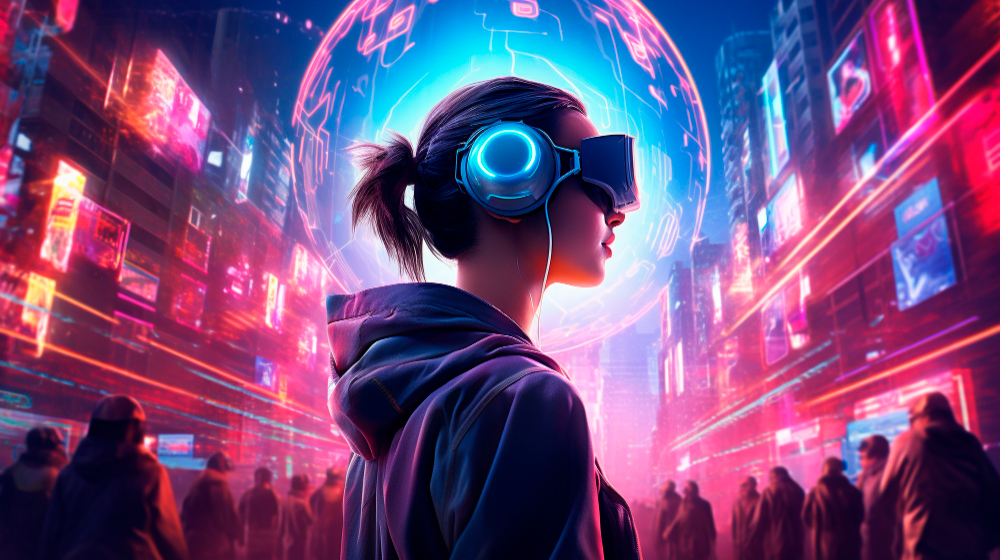Metaverse Game Development Trends Using Unreal Engine 5 & Spatial.io

The concept of the metaverse has shifted from science fiction to a tangible focus for many tech and gaming companies. It is essentially a digital space where users, represented by avatars, can connect, socialize, explore, create, own assets, and sometimes trade or earn revenue.
Market research indicates that the metaverse gaming sector is rapidly growing as a lucrative digital industry worldwide. Developers highlight features like cross-platform play, social interaction, real-time shared environments, and digital economies as key advantages.
Some of the prominent trends driving metaverse game development include:
- Cross-platform experiences
- Decentralised economies and digital asset ownership
- Social, persistent virtual worlds
- Immersive environments & realism
- Interoperability and continuity
Given this landscape, choosing the right engine (Unreal Engine 5 vs Unreal Engine 4) and platform becomes crucial. That’s where UE5 and Spatial.io come into play.
Key Takeaways
- Unreal Engine 5 provides a robust backbone for building high-fidelity metaverse worlds; Spatial.io offers an accessible platform for social hubs, UGC, and browser/VR reach.
- A hybrid architecture using UE5 for core world and Spatial.io for social hub offers a compelling strategy.
- Aligning with trends like cross-platform, digital ownership, social/UGC, and interoperability increases your chances of building a successful metaverse game.
- Careful attention is needed for performance, bridging engine and platform gaps, building a strong economy, providing community tools, and ongoing iteration post-launch.
Why Unreal Engine 5 is a Strong Choice for Metaverse Game Development
Selecting the right engine is crucial for developing a metaverse or virtual world, affecting quality, performance, scalability, and longevity. Unreal Engine 5 offers significant benefits:
High-fidelity visuals and cinematic quality
UE5 introduces Nanite virtualized geometry, Lumen global illumination, and upgraded asset pipelines, enabling near-photorealistic and complex scenes. For a metaverse game, this improves immersion. MindArk is transitioning Entropia Universe to UE5, highlighting its advanced graphics and tools.
Mature toolchain and ecosystem
UE5 provides a broad ecosystem with editor tools, visual scripting (Blueprints), C++ support, marketplace assets, MetaHuman for realistic avatars, and multi-platform capabilities. This ecosystem reduces risks and accelerates development for metaverse games.
Scalability & real-time rendering
UE5 enables large worlds, level streaming, asset management, and optimization for scalable, real-time metaverse environments. Nonetheless, building a genuinely persistent world involves additional backend infrastructure such as networking and server architecture.
Strong backing and recognition
UE5 is well-known in the AAA-game industry, attracting talent, assets, and studios. Since many metaverse projects strive for “AAA quality” or at least visually rich experiences, selecting UE5 indicates a serious commitment to quality.
Considerations
However, there are some caveats to keep in mind:
- Performance & accessibility: High-fidelity visuals mean higher hardware demands. For a broad metaverse reach (mobile, web), you’ll need careful optimisation or scalable LODs.
- Multiplayer / persistent world infrastructure: The engine is only part of the solution; server architecture, state synchronisation, economy systems, asset ownership, etc, must be built or integrated.
- Interoperability: While UE5 is strong, many metaverse platforms currently favour Unity or WebGL environments (which might be lighter for web).
- Cost/time: High-quality production requires higher budgets and longer development, posing a risk for emerging studios.
Given these pros and cons, UE5 remains one of the strongest choices for a visually and technically capable metaverse game engine.
Introducing Spatial.io and How It Fits into the Metaverse Game Pipeline
While UE5 is a game engine, platforms like Spatial.io provide a metaverse space for users to meet, interact, build, explore, and play. Understanding its capabilities and integration with UE5 is essential.
What is Spatial.io?
Spatial.io is a platform for virtual spaces accessible via browser, mobile, and VR, enabling creators to develop 3D environments, avatars, interactive setups, events, and games. Some key features:
- It supports web, mobile, and VR options, ensuring broad access.
- It provides a helpful “Creator Toolkit” (SDK) that, as of now, is designed around Unity (not UE5), making it easy to publish multiplayer spaces to the Web, mobile devices, and VR platforms.
- It supports user-generated content and monetization, aiming to become more accessible to creators.
- It is used for virtual events, galleries, and brand experiences, but it is gradually shifting toward gaming and social interaction settings.
Current Trends and How They Impact UE5 + Spatial.io Game Development
Building a metaverse game with UE5 and Spatial.io involves staying in line with major industry trends while carefully choosing your niche and technology. Here are some key trends and recommended responses.
Cross-Platform and Accessible Experiences
Players expect to jump between PC, console, mobile, web, and VR/AR. Browsers and mobile endpoints should be supported. Build your UE5 world with Level-of-Detail (LOD) strategies, scalable asset pipelines so you can target both high-end (PC/VR) and lighter clients (web/mobile). Use Spatial.io for broad reach (web/VR) while reserving the full UE5 build for high-fidelity modes. Ensure networking, UI/UX, and avatar systems are flexible and performance-optimised across device tiers.
Digital Ownership, Economies, and NFTs
If your game uses asset ownership, integrate blockchain or tokenisation. Consider compatibility with Spatial.io’s ecosystem. UE5 can render the asset-rich world; Spatial.io can serve as the marketplace or social space for asset display/trading. Design for asset interoperability: users should be able to bring their avatar/items into multiple spaces.
Social, Community, and UGC
Metaverse success hinges on social interaction, user-generated content, and persistent worlds. Provide tools/SDKs for players to create content (levels, skins, avatars). Thanks to Spatial.io, that has strong UGC features. Use UE5’s editor and runtime to support creation workflows, and then feed into Spatial.io hubs for social sharing.
Immersive and Realistic Environments
Advances in VR/AR have obliged developers to produce real-time rendering and photorealism. With UE5 you can push high-fidelity visuals, lifelike lighting, and realistic avatars. Leverage UE5 for flagship visuals, Spatial.io for accessible entry and E2E social experience.
Interoperability and Continuity
Players want continuity of identity, avatar, assets across games/worlds. Design your data model so avatars, assets, game progress can move between your UE5 world and Spatial.io social spaces. Support import/export of assets, avatar formats (e.g., Ready Player Me) and ensure clear API for bridging.
Sustainability & Performance
Large virtual worlds consume resources; sustainability is becoming a concern. Optimise asset creation and streaming pipelines in UE5; use efficient LODs, instancing, efficient mesh/texture workflows. Ensure network/server infrastructure scales efficiently.
What to Watch For (Pitfalls & Opportunities)
Here’s a table describing the opportunities and pitfalls.
| Opportunities | Pitfalls |
| First-mover advantage: While many metaverse projects exist, combining AAA quality (UE5) with broad accessibility (Spatial.io) can differentiate. | Over-engineering: Trying to build “everything” too early — huge worlds, complex economies, full VR support — may overwhelm small teams. |
| Creator economy: Empowering users to build, monetise, and share content fosters long-term engagement. | Performance/accessibility mismatch: If your UE5 world only works on high-end hardware, you risk excluding large user segments. |
| Brand/partnership synergy: Virtual events and galleries (via Spatial.io) offer new revenue lines beyond “just gaming.” | Unity/Spatial.io vs UE5 gap: Spatial.io has a strong Unity orientation; aligning a UE5 build with Spatial.io’s toolchain may require custom bridging. |
| Cross-device reach: Browser/VR integration lowers entry barriers and expands audience beyond hardcore gamers. | Economic design risks: Virtual economies can fail if asset scarcity, liquidity, and value models aren’t well designed. |
Conclusion
The metaverse game development is accelerating; players expect immersive, social, persistent, cross-platform worlds economies. With the right planning, team, tech stack, and metaverse game development company, 2025-26 provides a real opportunity to create standout metaverse games. Leveraging the power of UE5 together with the accessibility and UGC focus of Spatial.io puts you in a strong position.






